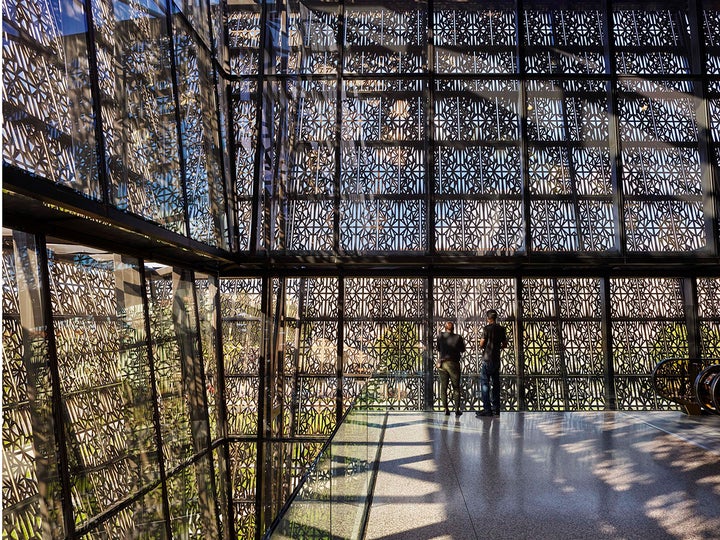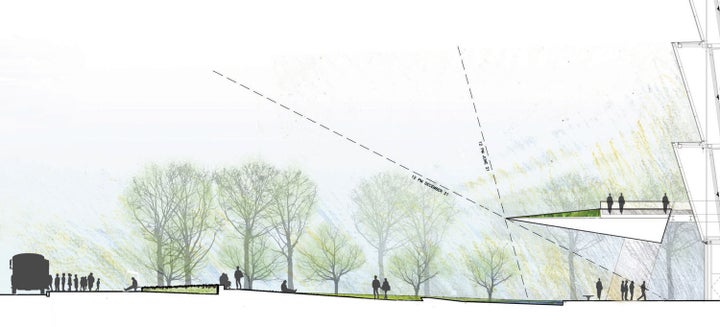
National Museum of African American History and Culture, west facade.
Washington, DC, could become the nation’s leader in sustainable design. The fourth and final article in a series about the National Museum of African American History and Culture.
Fifteen years ago, when I worked on the design of a high-performance museum, the concept was considered so unusual that the media questioned the very idea. The US Green Building Council (USGBC) had only very recently introduced its Leadership in Energy and Environmental Design (LEED) rating system, so much of the public wasn’t familiar with the concept. Over the following decade, it became more and more popular in every building type, including museums. A watershed year was 2008. The Water + Life Museums in Hemet, CA, became the first LEED Platinum museum, quickly followed by the California Academy of Science, which has been called “the world’s greenest museum.” The same year, the Grand Rapids Art Museum became the first LEED-certified art museum. By 2016, International Museum Day could highlight ten LEED-certified museums in the US alone.
Now the Smithsonian has completed its first LEED Gold project, the National Museum of African American History and Culture (NMAAHC). (The Silver-rated National Museum of the American Indian [NMAI] was the first Smithsonian project to become a certified green building, although it wasn’t designed to this standard and didn’t achieve it until seven years after opening in 2004.) By many measures, the NMAAHC is easily the greenest museum in Washington.
But the bar isn’t very high, unfortunately. Last year, the Smithsonian completed renovation of the Renwick Gallery, but it’s not clear from public records when or if LEED certification will be completed, although reportedly the building systems originally were designed to be very efficient. Earlier this year, the Smithsonian also reopened the historic Arts & Industries Building after a 12-year closure and an extensive renovation, but it didn’t pursue LEED, I’m told. The National Gallery also reopened the iconic East Building after a three-year refurbishment. No LEED. The Newseum opened in 2008. No LEED. Washington is said to be “in a class of its own when it comes to high quality museums,” but an article last year highlighting “must-see green museums” around the world included none in DC. What’s the problem?

Interior of the museum, with views of the exterior through the latticework.
At the time it opened, the Newseum’s director told the press that it didn’t get LEED certification “for reasons of cost.” This is a common misperception. In a 2008 survey of over 700 construction professionals, 80% cited “higher first costs” as the biggest obstacle to green building. Yet, even a dozen years ago the average surcharge for LEED projects was only 2%, and the additional investment typically yielded operational savings worth ten times that much, according to a widely cited report back then. By 2007, studies showed that LEED need not cost more at all, and now green building actually can cost less than conventional construction. The LEED-Platinum 1225 Connecticut Avenue, here in DC, cost about 5% below market rate construction in 2009 and sold for the highest price per square foot ever paid for an office building in the city.
Regardless, the fact that so few museums in DC are exemplars of sustainability makes the NMAAHC all the more remarkable. Its systems include “low-impact” materials, a nearly 100-kW solar array to produce energy on site, and efficient infrastructure connected to surrounding buildings to avoid redundancy. But the most impressive aspects of the building are how the basic design gestures conserve resources and enhance the visitor experience. The bronze-color metal tracery enveloping the façade is carefully calibrated to avoid undue heat gain while bathing the interior in soft light and allowing views in every direction. This lowers energy needs while improving occupant comfort (although the decision not to extend the screening to the ground floor results in occasionally heavy glare and uncomfortable temperatures when the sun is low, as I experienced one morning this winter). The latticework has another appeal that has been overlooked by reviewers and possibly by the designers themselves. As I documented in my book, The Shape of Green: Aesthetics, Ecology, and Design (2012), research shows that people generally crave the image of irregular tree-like patterns mimicking natural fractals—so much so that the pattern can lower stress by as much as 60 percent, just by being in our field of vision. The Japanese practice of forest bathing (Shinrin-yoku)—spending time immersed in wooded settings—can lower blood pressure, heart rate, and concentrations of stress hormones. Could the interior of the NMAAHC, like an artificial forest, have a similar effect?

The museum’s “porch” creates a comfortable microclimate at the entrance.
This research relates to the biophilia hypothesis, which suggests that people have an innate desire to connect with nature and other forms of life. An associated idea is the theory of “prospect/refuge,” which suggests that we seek out places that help us feel sheltered while allowing an uninterrupted view of our surroundings. A veranda or porch is a commonplace example. The main entrance to the NMAAHC is designed to act as a gigantic porch, inspired by traditions in African and African American vernacular building, as I pointed out in an earlier article. The prospect/refuge effect of this space is about as palpable as any I’ve ever witnessed. Additionally, the deep shade combined with a reflecting pool creates a cool microclimate intended to provide more comfort during the hot, humid summer months.
Washington has been called the “epicenter of green building,”and with the NMAAHC the city has significantly raised the bar for museums here and everywhere.
